

He was closely followed by Scott Joplin, who with the publication of the Maple Leaf Rag had the equivalent of a top ten hit. An all round entertainer, he did much to popularise ragtime allowing it to spread beyond its humble beginings.

Harney was one of the first practitioners to bring ragtime to the Vaudeville shows in New York. Another possible inspiration to Ragtime composers is the classical composer Louis Moreau Gottschalk (1829-1869) who almost anticipated ragtime with some of his lighter piano works which exhibit a blend of influences including Carribean music.īen R. Towards the end of each section or phrase there might be rising bass lines, changing harmonies or accidentals to give colour and emphasis to the cadences (phrase endings). Indeed ragtime may have drawn some inspiration from the military style marches of John Philip Sousa (1854-1932). This structure is similar to the classical form known as a Rondo, and to various dance forms and marches. They were usually in 2/4 time, and consisted of a number of contrasting 16 bar sections (sometimes with a middle "trio" section), with repetitions and returns to previous sections or a "Da Capo" (return to the begining). Despite the fact that the Right Hand syncopations were far in excess of anything produced in classical music, the structure of these pieces was nevertheless quite strict in a classical sense. The word Ragtime means "syncopated time", the main characteristic of these pieces being the Right Hand playing a syncopated tune while the Left Hand plays a simple regular line of alternating bass notes and simple chords, not unlike the "Alberti Bass" used in classical music by the likes of Mozart and Haydn. In its purest form Ragtime was played as an instrumental on a solo piano, an instrument which most honkytonk bars and saloons possessed.


 0 kommentar(er)
0 kommentar(er)
